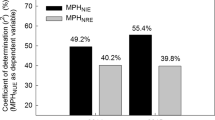Abstract—
The response of maize hybrids to nitrogen fertilizer as a hereditary character was investigated. A hybrid combination with the original parental inbreds with a strong response to nitrogen fertilizer was developed for this purpose (according to the studies conducted in 2012–2014). The growth of the vegetative part and root system mass of plants in maize lines and hybrids at the five-leaf stage, height, and yield of green mass and grain were taken as criteria for evaluating the response. The hybrid combination obtained by breeding showed significantly higher growth of green mass of plants and mass of the root system at the five-leaf stage during testing in 2015–2019. The increase was respectively 2.12 and 0.37 g under nitrogen fertilization. It was demonstrated that the hybrid Eksperimental’nyi was of greater growth in plant height (4 cm), significantly higher increase in green mass yield (2.8 t/ha), and grain yield (0.24 t/ha) compared to the control Mashuk 355 MV. The new hybrid used nitrogen more efficiently to create additional protein, whose content in grain increased by 0.93%, which was 0.42% higher than in the hybrid Mashuk 355 MV. The specific response of the hybrid combination of maize to nitrogen fertilizer was proven, which is directly associated with the genotype characteristics inherited from the parental inbreds. The selection of a starting material with a heavy response to nitrogen fertilizer and its application in hybridization made it possible to obtain the hybrid combination Eksperimental’nyi. It was superior to the hybrid Mashuk 355 MV in nitrogen response. These results were used to evaluate the starting material and its selection in developing efficient maize hybrids responsive to nitrogen fertilizer.
Similar content being viewed by others
REFERENCES
Agafonov, E.V. and Batakov, A.A., Fertilization system for corn hybrids of various ripening periods on the dark chestnut soil of Rostov region, Agrokhimiya, 2000, no. 11, pp. 41–50.
Ageev, V.V. and Podkolzin, A.I., Sistema udobreniya v sevooborotakh Yuga Rossii (Fertilization System in Crop Rotations in the South of Russia), Stavropol, 2001, pp. 191–201.
Belay, A., Claassens, A. and Wehner, F., Effect of direct nitrogen and potassium and residual phosphorus fertilizers on soil chemical properties, microbial components and maize yield under long-term crop rotation, Biol. Fertil. Soils, 2002, no. 6, pp. 420–427.
Tremblay, N., Bouroubi, Y.M., Bélec, C., Mullen, R.W., Kitchen, N.R., Thomason, W.E., Ebelhar, S., Mengel, D.B., Raun, W.R., Francis, D.D., Vories, E.D., and Ortiz-Monasterio, I., Corn response to nitrogen is influenced by soil texture and weather, Soil Fertil. Crop Nutrit., 2012, vol. 104, pp. 1658–1671.
Klimashevskii, E.L., The theory of agrochemical efficiency of plants, Agrokhimiya, 1990, no. 1, pp. 131–148.
Klimashevskii, E.L., Geneticheskii aspekt mineral’nogo pitaniya rastenii (The Genetic Aspect of Mineral Nutrition of Plants), Moscow: Agropromizdat, 1991.
Metodicheskie rekomendatsii po provedeniyu polevykh opytov s kukuruzoi (Methodical Guidelines for Field Experiments with Corn), Dnepropetrovsk: VNII Kukuruzy VASKhNIL, 1980.
Dospekhov, B.A., Metodika polevogo opyta (Methodology of Field Experiments), Moscow: Kolos, 1979.
Bagrintseva, V.N. and Ivashenenko, I.N., Features of development of self-pollinated lines of maize when applying nitrogen fertilizer, Kukuruza Sorgo, 2015, no. 2, pp. 22–30.
Bagrintseva, V.N. and Ivashenenko, I.N., Responsiveness to nitrogen fertilization in modern corn hybrids in Stavropol Krai, Agrokhimiya, 2015, no. 11, pp. 45–50.
Bagrintseva, V.N. and Ivashenenko, I.N., Responsiveness of maize hybrids and their parental forms to nitrogen fertilizer, Russ. Agric. Sci., 2017, vol. 43, pp. 376–380.
Klimashevskii, E.L., Fiziologicheskie osobennosti pitaniya raznykh sortov kukuruzy (Physiological Nutritional Characteristics of Maize Cultivars), Moscow: Nauka, 1966.
D’yachkov, V.F., Effect of fertilizers on the chemical composition of corn hybrids of various early maturity, Sb. Nauchn. Tr. Voronezh. S-kh. Inst., 1975, vol. 72, pp. 89–92.
Ivashenenko, I.N. and Bagrintseva, V.N., The role of nitrogen fertilization in increasing the yield and fodder value of grains in maize hybrids, Zhivotnovod. Kormoproizvod., 2018, no. 2, pp. 168–175.
Oikeh, S.O., Kling, J.G., and Okoruwa, A.E., Nitrogen fertilizer management effects on maize grain quality in the West African moist savanna, Crop Sci., 1998, vol. 38, no. 4, pp. 1056–1161.
Author information
Authors and Affiliations
Corresponding author
Ethics declarations
The authors declare that they have no conflict of interest. This article does not contain any studies involving animals or human participants performed by any of the authors.
Additional information
Translated by N. Bogacheva
About this article
Cite this article
Bagrintseva, V.N., Ivashenenko, I.N. Evaluating the Response of Maize Hybrids to Nitrogen Fertilizer. Russ. Agricult. Sci. 47, 17–20 (2021). https://doi.org/10.3103/S1068367421010031
Received:
Revised:
Accepted:
Published:
Issue Date:
DOI: https://doi.org/10.3103/S1068367421010031




